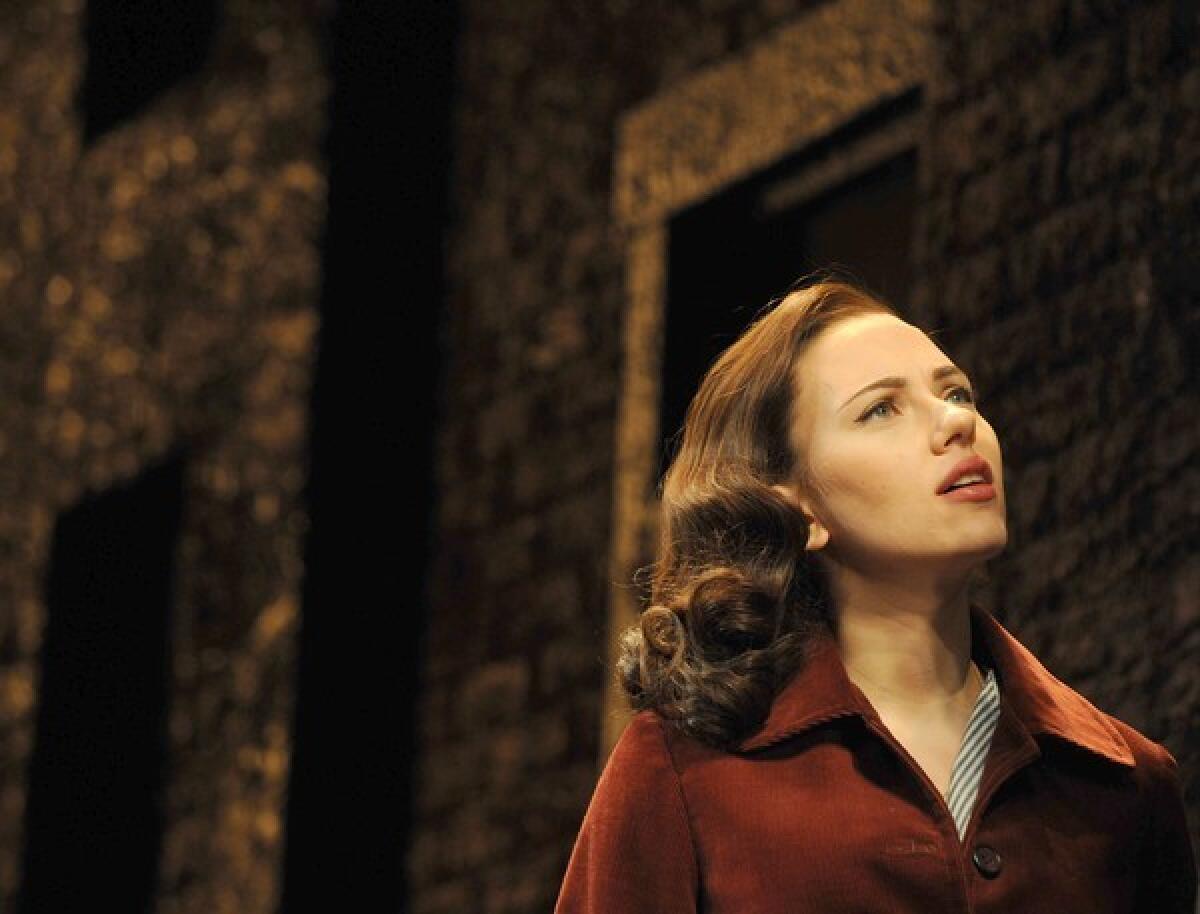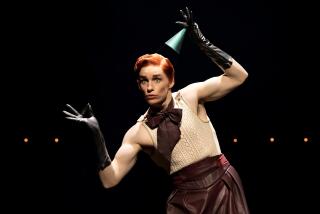Scarlett Johansson finds herself on a new stage -- Broadway

Scarlett Johansson started acting early -- although she’s just 25 years old, her performing career already spans 16 years -- and knows the usual drill. “I’m really used to a camera following me,” she says.
Yet for all of her movie work -- “Lost in Translation,” “Match Point,” “Girl With a Pearl Earring,” “Ghost World,” to name a handful of her prominent roles -- Johansson has never acted for something far less forgiving than 35mm film: a live theater audience.
Many actors have peppered their performing credits with the occasional theater gig; a summer stock show here, maybe a regional musical there. But Johansson started film acting, fell in love with it -- “It’s all I know,” she says -- and never left. By her recollection, the last play she performed in was an elementary school production of “Oliver!”
Her subsequent stage role is a little bit bigger: Catherine, the center of a tragic, sexualized battle in the Broadway revival of Arthur Miller’s “A View From the Bridge.” Says the actress in her backstage dressing room a few days before the show opened Jan. 24 to largely positive reviews: “It felt like it was a good time for me.”
Rather than shrug off the transition with the “acting is acting” line, Johansson says the move has been alternately thrilling and terrifying, challenging and rewarding, and -- at times -- has made her appreciate that for all of her accomplishments, she is still growing as an actor.
It was a point driven home as the play was in previews, when Johansson found herself acting alone -- even though she was sharing the stage at the time.
Through weeks of rehearsals for Miller’s play about improper feelings in an Italian immigrant home, Johansson was playing opposite Santino Fontana as Rodolpho. It’s one of the most critical pairings in Miller’s 1955 play, as Rodolpho is the man who sweeps the 17-year-old Catherine off her feet and out of the grasp of her inappropriately protective uncle, Eddie, played by Liev Schreiber.
But several days before the play’s premiere at the Cort Theatre, Schreiber threw Fontana a little too roughly in a preview performance, and the actor, who suffered a whiplash concussion, had to leave the show.
Johansson suddenly was playing opposite Fontana’s understudy (Morgan Spector), and although the new actor had little in common with his predecessor, Johansson says she didn’t change her performance accordingly: She was acting by herself, inside a bubble and not with the person right next to her.
“I felt terrible about that performance. I fell back on all of these habits,” Johansson says a few days before the show’s opening, in which several critics praised her performance. “I was not being truthful.”
She believes the experience with the understudy was “a fantastic thing” in that it ultimately made her a better stage actress (Spector in due course was named as the show’s permanent Rodolpho). Yet it was only one of the many teachable moments Johansson experienced as the play came together.
Launching pad
With 2003’s “Lost in Translation,” Johansson emerged as a complicated, charismatic actress caught between the innocence of adolescence and the maturity of womanly independence.
She was only 18 when writer-director Sofia Coppola’s Oscar-winning movie about an oddly platonic relationship between a young woman (Johansson) and a middle-age man ( Bill Murray) was released. “It’s wonderful to see her naturalness, empathy for character and skill allow her to hold her own with someone as experienced and idiosyncratic as Murray,” Times film critic Kenneth Turan wrote at the time.
Johansson’s career was transformed by the part. Outside of the Michael Bay misfire “The Island,” she largely steered away from big-budget movies (although she’ll be in this summer’s sequel “ Iron Man 2”), choosing instead to work with distinctive filmmakers such as Christopher Nolan (“The Prestige”), Woody Allen (“ Vicky Cristina Barcelona,” “Match Point”) and Paul Weitz (“In Good Company”).
Johansson, who grew up watching Broadway musicals, previously had wanted to adapt “A View From the Bridge” for the screen, after seeing an earlier revival with Anthony LaPaglia as Eddie. Johansson pictured LaPaglia playing the same part and herself as Catherine. Like so many movie ideas, this one didn’t go anywhere.
Not that long ago, she was approached by director Gregory Mosher, was looking for an actress as vulnerable as she was tough. “I needed to find someone to convincingly play a 17-year-old but who also had the presence to go toe-to-toe with Liev Schreiber and not get blown off the stage,” the Tony-winning director and producer said.
Johansson, who recently married “The Proposal” star Ryan Reynolds, was intrigued but believed she wasn’t young enough to play Catherine anymore.
“When the project came back to me, it was so bizarre -- it was like a ghost from the past,” she says. “I never wanted to do it on stage. But I also felt I was too old.”
The more Johansson thought about the offer, though, the more she wondered if the distance from her adolescence had brought a more meaningful -- and informed -- point of view. That Schreiber would be on stage with her was critical too.
“Somehow, I probably had a better perspective than when I was 18 or 19,” she says. And her friends encouraged her to say yes, even if she would be making her professional theatrical debut playing a vital part in a landmark play -- on Broadway, no less.
“I wanted to be a little bit scared,” says the actress, who just released the album “Break Up” with Pete Yorn. “It would be a real challenge, but in the best way.”
Unlike with any movie role, Johansson had weeks of rehearsal with Schreiber, Jessica Hecht (as Eddie’s wife, Beatrice), Michael Cristofer (Alfieri) and Corey Stoll (Marco). Mosher says she had “the whole New York thing down -- not just the accent, but the attitude and the energy,” but needed to learn that “you have to act with your whole body” and never play the role exactly the same way twice.
Johansson says that she needed to figure out how to play to a theater, not just a room; rather than waiting for feedback from a film director, she had to sense how the audience was reacting.
“It’s so unfamiliar to me, so I put up a wall there,” she says. “I can sense the audience, but I didn’t yet have the relationship with them in the same way I have a relationship with a camera, which is funny. When you’re doing film acting, it’s very hard to have a perspective on your performance -- that’s why you need a great director, a second pair of eyes, that you trust and is following your story.”
Inside a theater in the middle of a performance, that role shifts to the audience, her fellow actors and Johansson herself. And along the way she has found herself examining her acting habits, “some of the things that have been limiting me.”
Equally complicated was trying to sort out Catherine’s emotions. “It is a lot to cover,” the actress says.
Catherine is incredibly loyal to her uncle and isn’t initially sophisticated enough to know that Eddie doesn’t exactly have her best interests in mind. At the same time, Rodolpho’s arrival -- and a pending new job in a plumbing office -- awakens in Catherine new feelings about herself, her future, her independence.
Those feelings
“I’ve never spent so much time feeling uncomfortable, embarrassed -- all of these emotions we are supposed to avoid,” Johansson says. “There were days when I had this realization -- and this is going to sound corny -- that it was so challenging and so rewarding. It was a whole new world.”
She and Schreiber spent much of their rehearsal time sorting out their characters’ bond. “They have this incredibly complicated and touching and perhaps inappropriate relationship,” she says. At first, “it’s pretty innocent,” and then there’s the play’s famous kiss. Unlike a movie set, however, the actors could spend days -- if not weeks -- figuring out how to stage a scene. “In the film world, we would have about 15 minutes to solve these problems. And if we didn’t, it would cost us thousands of dollars.”
Johansson is the latest Hollywood star to make his or her way to Broadway. The trend -- which has helped sell tickets to plays, including “All My Sons” with Katie Holmes -- has opened film actors to criticism as carpetbaggers.
Johansson knows those shots are part of the deal. “Yes, of course I am going to be on the hot seat,” she says, imagining what her detractors might say. “Who the hell do I think I am coming up here? I’ve got no formal training, and I haven’t been pounding the pavement on 42nd Street.
“At first,” she continues, “I felt a little self-conscious about it. But Liev told me, ‘The audience wants you to succeed.’ I actually never think about the financial part of it -- the pressure to sell tickets. I only promise to show up on time and do my part. And I just hope I will have the opportunity to do it again.
“I am learning,” she says, glancing at a note on her dressing room mirror reminding her to twirl in one scene. “I’m learning each show, more and more.”
More to Read
The biggest entertainment stories
Get our big stories about Hollywood, film, television, music, arts, culture and more right in your inbox as soon as they publish.
You may occasionally receive promotional content from the Los Angeles Times.







